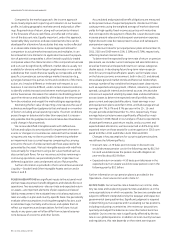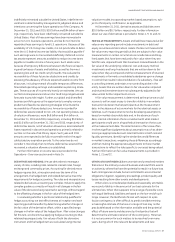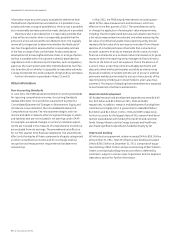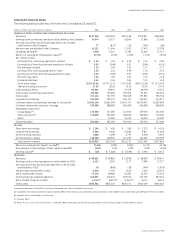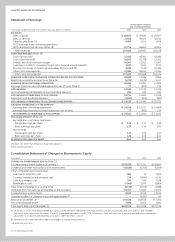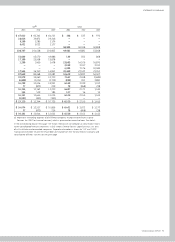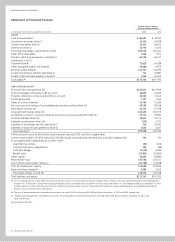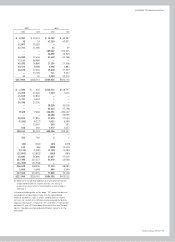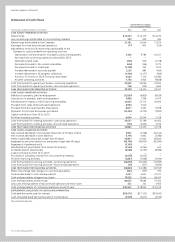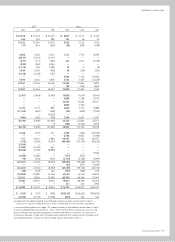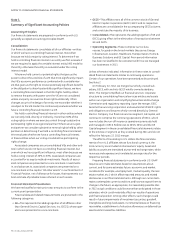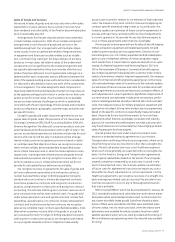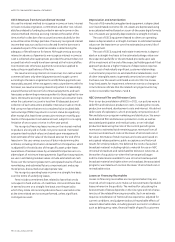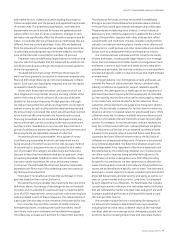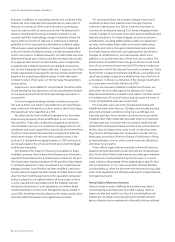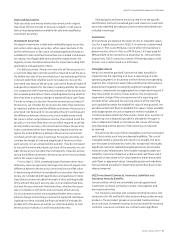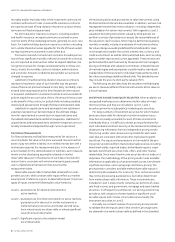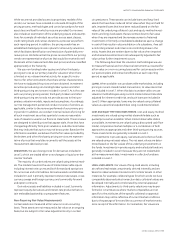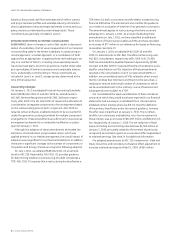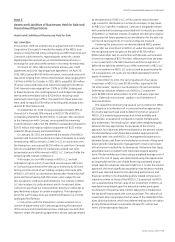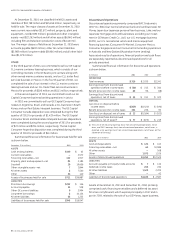GE 2011 Annual Report Download - page 78
Download and view the complete annual report
Please find page 78 of the 2011 GE annual report below. You can navigate through the pages in the report by either clicking on the pages listed below, or by using the keyword search tool below to find specific information within the annual report.
76 GE 2011 ANNUAL REPORT
Note 1.
Summary of Significant Accounting Policies
Accounting Principles
Our fi nancial statements are prepared in conformity with U.S.
generally accepted accounting principles (GAAP).
Consolidation
Our fi nancial statements consolidate all of our affi liates—entities
in which we have a controlling fi nancial interest, most often
because we hold a majority voting interest. To determine if we
hold a controlling fi nancial interest in an entity we fi rst evaluate if
we are required to apply the variable interest entity (VIE) model to
the entity, otherwise the entity is evaluated under the voting
interest model.
Where we hold current or potential rights that give us the
power to direct the activities of a VIE that most signifi cantly impact
the VIE’s economic performance combined with a variable inter-
est that gives us the right to receive potentially signifi cant benefi ts
or the obligation to absorb potentially signifi cant losses, we have
a controlling fi nancial interest in that VIE. Rights held by others
to remove the party with power over the VIE are not considered
unless one party can exercise those rights unilaterally. When
changes occur to the design of an entity we reconsider whether it
is subject to the VIE model. We continuously evaluate whether we
have a controlling fi nancial interest in a VIE.
We hold a controlling fi nancial interest in other entities where
we currently hold, directly or indirectly, more than 50% of the
voting rights or where we exercise control through substantive
participating rights or as a general partner. Where we are a gen-
eral partner we consider substantive removal rights held by other
partners in determining if we hold a controlling fi nancial interest.
We reevaluate whether we have a controlling fi nancial interest
in these entities when our voting or substantive participating
rights change.
Associated companies are unconsolidated VIEs and other enti-
ties in which we do not have a controlling fi nancial interest, but
over which we have signifi cant infl uence, most often because we
hold a voting interest of 20% to 50%. Associated companies are
accounted for as equity method investments. Results of associ-
ated companies are presented on a one-line basis. Investments
in, and advances to, associated companies are presented on a
one-line basis in the caption “All other assets” in our Statement of
Financial Position, net of allowance for losses, that represents our
best estimate of probable losses inherent in such assets.
Financial Statement Presentation
We have reclassifi ed certain prior-year amounts to conform to the
current-year’s presentation.
Financial data and related measurements are presented in the
following categories:
• GE—This represents the adding together of all affi liates other
than General Electric Capital Services, Inc. (GECS), whose oper-
ations are presented on a one-line basis.
• GECS—This affi liate owns all of the common stock of General
Electric Capital Corporation (GECC). GECC and its respective
affi liates are consolidated in the accompanying GECS columns
and constitute the majority of its business.
• Consolidated—This represents the adding together of GE and
GECS, giving effect to the elimination of transactions between
GE and GECS.
• Operating Segments—These comprise our six busi-
nesses, focused on the broad markets they serve: Energy
Infrastructure, Aviation, Healthcare, Transportation, Home &
Business Solutions and GE Capital. Prior-period information
has been reclassifi ed to be consistent with how we managed
our businesses in 2011.
Unless otherwise indicated, information in these notes to consoli-
dated fi nancial statements relates to continuing operations.
Certain of our operations have been presented as discontinued.
See Note 2.
On February 22, 2012, we merged our wholly-owned sub-
sidiary, GECS, with and into GECS’ wholly-owned subsidiary,
GECC. The merger simplifi ed our fi nancial services’ corporate
structure by consolidating fi nancial services entities and assets
within our organization and simplifying Securities and Exchange
Commission and regulatory reporting. Upon the merger, GECC
became the surviving corporation and assumed all of GECS’ rights
and obligations and became wholly-owned directly by General
Electric Company. Our fi nancial services segment, GE Capital, will
continue to comprise the continuing operations of GECC, which
now includes the run-off insurance operations previously held
and managed in GECS. References to GECS, GECC and the GE
Capital segment in these consolidated fi nancial statements relate
to the entities or segment as they existed during 2011 and do not
refl ect the February 22, 2012 merger.
The effects of translating to U.S. dollars the fi nancial state-
ments of non-U.S. affi liates whose functional currency is the
local currency are included in shareowners’ equity. Asset and
liability accounts are translated at year-end exchange rates, while
revenues and expenses are translated at average rates for the
respective periods.
Preparing fi nancial statements in conformity with U.S. GAAP
requires us to make estimates based on assumptions about
current, and for some estimates future, economic and market
conditions (for example, unemployment, market liquidity, the real
estate market, etc.), which affect reported amounts and related
disclosures in our fi nancial statements. Although our current esti-
mates contemplate current conditions and how we expect them to
change in the future, as appropriate, it is reasonably possible that
in 2012 actual conditions could be worse than anticipated in those
estimates, which could materially affect our results of operations
and fi nancial position. Among other effects, such changes could
result in future impairments of investment securities, goodwill,
intangibles and long-lived assets, incremental losses on fi nancing
receivables, establishment of valuation allowances on deferred tax
assets and increased tax liabilities.


